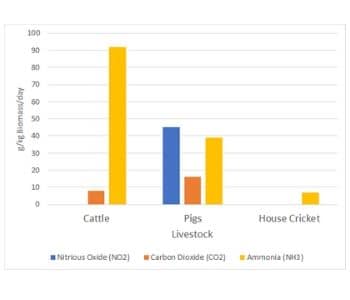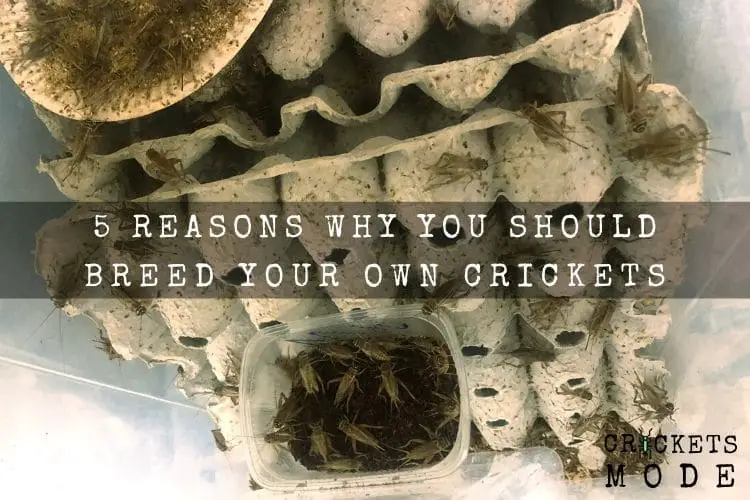I decided to build a cricket farm and raise my own crickets after I understood crickets‘ benefits to:
- Humans
- Animals
- Plants
- Environment
I mean, if you look closely, these points are the pillars to our planet. Without all of them not much will be left, so we have to take care of those pillars by spreading the information how crickets are good for you! This is what I try to do with this blog:)
I didn’t jump into crickets overnight though. There are many studies made providing strong evidence about the advantages of crickets, which I dug deep before I was convinced that crickets are a good choice!
Back in 2013 United Nations Food and Agriculture Organization released a report, saying that eating insects could help boost nutrition and reduce pollution. If you didn’t know, today already +2 billion people worldwide already supplement their diet with insects. Though, this is obviously more popular in Eastern word. In the West “yuck” factor still exists.
Anyways, I don‘t want this to be another cliché post by writing about the aim of “world peace and prosperity in humanity“. To reach global welfare we should aim for the big but start small, right? Let’s start from ourselves.
Worth mentioning that raising and breeding crickets is not rocket science and if done smart, it won‘t require much effort.
From my experience, as a crickets farmer, I usually distinguish 5 top reasons why people want to raise and breed their own crickets.
#1 Breeding Crickets As Pet Food: What Animals Eat Crickets?
As declared in UN report, crickets are very nutritious. And what loves insect crickets the most? – Lizards!
Yes, reptile pet owners make big part of crickets market customers.
Crickets is a delicacy to majority of reptiles, If you own any of the below lizards, you should definitely try feeding it with live crickets:
- Bearded Dragon
- Gold-Dust Day Gecko
- Leopard Gecko
- Crested Gecko
- The Chameleon
- Anoles
- African Fat Tail Geckos
- Blue-Tongue Skink
TIP: If you want to learn more about what animals/predators eat crickets, there‘s a paragraph in my other post How Long Do Crickets Live
Today we have bunch of companies which grow and breed crickets comercially and you don‘t need to take worry about it. Click “order now” and the package will arrive to your door step within few days or faster.
Of course, it’s convenient, but is it optimal financially?
Breed Your Own Crickets & Save Money: An Example
Let’s say you own a bearded dragon. Fully grown bearded dragon eats 50-70 live crickets per week, depending on its side. So, within a month you will need around 200-300 live crickets. On Amazon you can buy 250 live crickets for around $20 (€18). Within a year you will spend $240 (€215) only for bearded dragon crickets! And I’m sure that’s not the only expense you will have for your pet.
If you buy live crickets, you still have to take care of them until they are all in you bearded dragon’s stomach, right? So, you buy live crickets and still need to take care of them?
Here’s an idea: Why don’t you buy live crickets only once, breed them yourself and don’t ever buy from Amazon because you will have your own crickets all the time?
Actually, breeding crickets is easier than you think. I recently made an ultimate guide about how to raise and breed your own crickets. Give it a shot!
#2 Breeding Crickets for Fishing
Crickets can work great as live fishing bait in fresh waters. With crickets you can catch various fish, such as:
- Crappie
- Yellow perch
- Brook trout
- Bluegills
- Etc.
The benefit of using live crickets for fishing is that crickets move a lot, so often to lure fish can be easier comparing to other live bait options.
I mean, facts speak for themselves. Check out this guy using live cricket and soon seeing promising results!
If you haven‘t tried fishing on live crickets, you should definitely at least give it a shot. You can get live crickets on Amazon here. Sometimes local shops sell live crickets as well, but you should save time and call them first to check if they have any.
If you will try live crickets as fish bait and will find promising results, you should consider raising your own crickets. Sounds a lot of work? Well, it should, because we have you covered!
In my other post I show how to raise and breed crickets the right way. It’s really simple, the post will guide you through the necessary steps.
I understand, that it doesn’t cost a fortune to buy live crickets from time to time, but usually the lowest amount of crickets you can buy it around 50.
Probably during one fishing sessions you will only use couple of them. What will you do with the rest, throw them away? Sounds like a waste to me.
Hence, it would make more sense to raise and breed your own crickets if you‘re fishing actively. When you go fishing, simply take few live crickets in a small container with few holes and you‘re good to go! The rest of the crickets will stay at home calmly waiting for your next fishing session.
So, before you go fishing with your standard bait, at least give it a through about growing your own crickets and use them as bait.
P. S. What could be more satisfying than catching a fish with the bait your raised yourself?
#3 Breeding Crickets for own usage: Are Crickets Good For You?
It may sound odd to some people, but I actually eat crickets few times a week. Yes, to me it‘s easy to say and do, because I own cricket farm, so I have the supply.
Others may think: why on earth should I even bother eating crickets or even think of raising them? Well, let‘s see what science has to say about it.
Health Benefits When Eating Crickets: Study
In 2018 an experiment was made at University of Wisconsin-Madison where 20 women and men were selected. Half of them ate breakfast with 25 grams of cricket powder for two weeks. The results showed that crickets may improve gut health and reduce systemic inflammation.
Another study, performed in 2016 compared if edible insects were more or less ‘healthy‘ than commonly consumes meats. As a result, you can see below table showing that nutritious value of a cricket (left bar) outperformed all tested insects except honeybee and outperformed al meat types (beef, pork, chicken).

Nutrients in Crickets
On average crickets contain:
- ~55% of protein
- Essential amino acids
- Omega 3 fatty acids
- Omerca 6 fatty acids
- High calcium
- Vitamin B12
In comparison (3.5 oz (100gr) serving):
| Dried Crickets | Dried Beef | Chicken |
| 55% Protein | 43% Protein | 13% Protein |
Nutrients In My Farm‘s Crickets
I have made official tests of my house crickets to understand how much protein and other relevant nutrients my crickets contain. Here you can see the results of my crickets nutritional value. People who know at least a bit about crickets or are into crickets business always firstly ask: “so, what’s your crickets’ protein percentage?”
My crickets contain 59,5% of protein (dried powder). If results are around 60% then you are considered above the market level. I’ve seen results when crickets had only 45% of protein and less. In any case, it’s still more than beef or chicken.
Test results can depend on cricket feed, when and how crickets were harvested. I will write about it next time though.

As you can see from stated results, there are many positive facts that crickets are densely nutritious.
Crickets: Greenhouse Gas Emissions
Even if crickets were on the same nutritious value bar as meat, it would still make sense at least for a day or two per month switch from meat to crickets, because crickets‘ emissions are x10 times lower (on average) than cows (i.e. beef).
A study has shown that crickets‘ greenhouse gas emissions were multiple times lower comparing to cattle and pigs livestock

I could go on and on about crickets‘ advantages (as food) versus meat. Though, my intention was only to show that crickets are truly beneficial for humans. Hence, why not give cricket food a try and at least taste it, hm?
Here you can find few brands which provide cricket powder, dried crickets and even cricket cookies!
- Dried crickets (Natural flavor as a snack, 3 packs)
- Dried crickets (BBQ flavor as a snack, 3 packs)
After you try those crickets‘ products (I guarantee you will love the taste), you may want to consider raising and breeding your own little cricket farm at home.
It‘s really simple setup and doesn’t require too much labor as long long as you know what you‘re doing. That‘s why I made this guide how to raise and breed your own crickets. Check it out!
I mean, who wouldn’t want to brag to a co-worker that at home you have built your own small cricket farm where you raise and breed crickets by yourself for your own consumption? Such fact would be hard to beat!
#4 Cricket Poop: Organic Fertilizer (AKA Cricket Droppings)
In my cricket farm I grow 440 pounds (~200 kg) of crickets and I have to deal with dozens pounds of cricket poo every growing cycle.
Cricket Droppings are small, round and black. It looks similar to poppy seed, just a little bit smaller. Cricket droppings work great as soil fertilizer. Actually, after I harvest my crickets, the first thing I do is taking the cricket containers (without crickets) and sift the whole content. I do this to separate the actual cricket droppings from food leftovers and other remains. Crickets droppings is usually called as cricket frass.
Cricket Droppings: Benefits
Cricket poo contains a lot of nitrogen, iron & other relative nutrients which are crucial for your garden’s plants. Cricket droppings is as good fertilizer as cow or chicken fertilizer. Though, the advantage of cricket poo is that it’s has dry texture and doesn’t smell if you prepare it properly.
Despite nutrient value in cricket poo, it serves for plants as additional purpose, which is called secondary metabolite. Plants produce a secondary metabolite that works as defense mechanism from herbivores and microorganisms.
If to put it in simple words, if you put some cricket poo in the soil for your plants it will help your plant to be protected from various herbivore insects and microorganisms which can harm your plants. So, cricket poo is a great organic way for your plants to be prevented from harmful organisms.
So, if you were convinced by any of the above-mentioned points why you should raise and breed your own crickets, cricket droppings will be your bonus because it will come naturally as an organic side product of your crickets!
By the way, if you have some plants and would like to try our cricket droppings before start raising your own crickets, you can get cricket frass online.
When you decide (I‘m sure you will) to actually raise and breed your own crickets, I’ve made a guide for you to follow, so that your cricket raising and breeding process is as smooth as possible!
#5 Breeding Crickets for Profit: Cricket Farmer‘s Advise
I built my cricket farm not only to become a part of sustainable food producers‘ community and do something actually useful to the environment, but also to make side income.
Cricket farming can be a really profitable business niche if you do it the smart way. Though, there are multiple dependencies. Let‘s start with the most interesting part: the profit expectations by raising and breeding crickets.
How Much Profit Can I Make By Raising Crickets?
I will assume you want to grow crickets as a wholesaler and be production supplier to third party companies. Meaning, you don‘t think of selling your crickets‘ harvest as food for final consumer by putting your product on shelf in a shop.
If you think of selling your crickets as food, then you will need to go through all legal governmental requirements to be eligible to produce the food in commercial kitchen which is highly regulated by law. We speak here about tens of thousands of dollars/euros.
Alright, let‘s assume we have established now that you will raise and breed crickets as a cricket production supplier. It means you will grow your crickets, harvest them, put in freezer and sell to third-party company which will take the production further.
Cricket Wholesale Price: Example Calculation
In 2020, wholesale frozen crickets price: ~$8 per pound (~€16 per kilogram).
So, if you would have a commercial farm of 323 square feet (30 square meters), you could raise 440 pounds (~200 kg) of crickets. It means your revenue could be around $3 520 (€3 153) per cricket cycle which is around 6-7 weeks.
On average per month you could make $2 350 (€2 105) of revenue by raising crickets in a commercial farm.
Note, that this amount is before expenses, which you will have plenty when you will start building the farm. Though, after the farm is fully functioning you will basically have only operational expenses, which means that only the beginning will require money investment, but later the costs should flatten out and your cricket farm will sustain itself.
The main costs you will have when cricket farm is functioning cricket feed, electricity, labor (which for sure you should do everything yourself at least at the beginning). It wouldn’t take more than 35% of your revenue.
So, these are the basic numbers which you could expect by raising crickets for profit commercially. Note, that these numbers are only to give you and idea about potential profits, though, these numbers can be largely different depending on competition in your area, supply needs and many other factors. Please don’t take this number for granted.
Selling Crickets to Local Pet Stores
In comparison, a good idea for cricket farmer beginner is to start small, with few cricket containers or so.
Here’s a plan for you, before you even start raising crickets for profit on low scale:
- Scout through Google search to find all pet stores and pet supply companies
- Make a list of all pet stores/pet supply companies in your area (I suggest not further than 50mi (80km))
- Send proposal emails to all of them asking if they need a supply of live or frozen crickets. Even better option would be to straight call them or show up in their store. Though, usually it’s not the owner who’s behind the cashier, so you should probably call them first.
- Count how many of them are interested in your proposal.
- Agree that in upcoming month you will be able to supply your first batch of live or frozen crickets.
By following these steps, you will not risk investing money in advance before you even have a clue if you will be able to sell the crickets you grow.
After you will get your first deal, you should go through my guide of how to raise and breed your own crickets, so you are properly ready to grow healthy and nutritious crickets!
